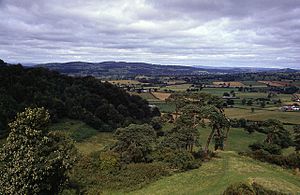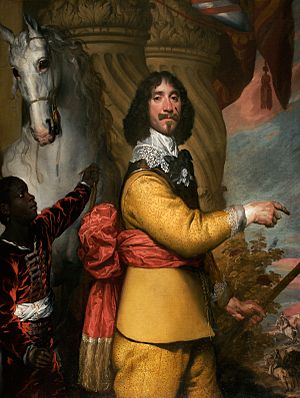Relief of Montgomery Castle facts for kids
Quick facts for kids Battle of Montgomery |
|||||||
|---|---|---|---|---|---|---|---|
| Part of First English Civil War | |||||||
 A view north from Montgomery Castle, looking towards the battlefield (the flat area) |
|||||||
|
|||||||
| Belligerents | |||||||
| Commanders and leaders | |||||||
| Lord Byron | Sir John Meldrum Colonel Thomas Mytton |
||||||
| Strength | |||||||
| 2,800 infantry 1,400 cavalry 300 dragoons |
2,000 infantry 1,500 cavalry |
||||||
| Casualties and losses | |||||||
| 500 killed 1,500 captured |
40 | ||||||
The Battle of Montgomery was an important fight during the First English Civil War. This war happened in England and Wales between 1642 and 1646. On 17 September 1644, a Parliamentarian army, led by Sir John Meldrum, moved to attack a Royalist army. The Royalist forces, commanded by Lord Byron, were trying to capture Montgomery Castle in mid-Wales. The main battle took place the next day. Even though the Royalists started well, the Parliamentarians fought back strongly. They ended up defeating Lord Byron's army completely.
After this battle, the Royalists still had some control in North and Mid Wales. However, they could not gather a large army in the area again until the war was almost over.
Contents
Why Did the Battle Happen?
Royalist Support in Wales
Many people in Wales supported the Royalists during the English Civil War. The Royalists were followers of King Charles I. Throughout 1643, Royalist leaders in Wales often fought against Parliamentarian forces. These Parliamentarian groups were based in the Midlands of England. Their commanders included Sir Thomas Myddelton and Colonel Thomas Mytton.
King Charles's Plan
Late in 1643, King Charles tried to create a new army in North Wales and Cheshire. He used English soldiers who had returned from Ireland. These soldiers came back after a peace agreement was made there. Lord Byron was put in charge of this new army. But Byron's plans faced a problem early on. He suffered a defeat at the Battle of Nantwich in January 1644.
Prince Rupert's Movements
In the spring of 1644, Prince Rupert arrived in Shrewsbury. He was the King's nephew and a very popular military leader. In May, he took his own army and Byron's army into Lancashire. They were on their way to help the city of York, which was under attack. Myddelton and other Parliamentarian leaders saw this as a chance. They captured Oswestry on 22 June while Rupert and Byron were away.
Parliamentarian Gains
On 2 July, Prince Rupert's army was defeated at the Battle of Marston Moor near York. He retreated with his remaining soldiers into Lancashire and then Cheshire. He couldn't find new soldiers in North Wales or get more help from Ireland. So, he went south to join King Charles. This left Byron's army weaker and in charge of the area. In August, Byron was forced out of Lancashire. This left Liverpool as the only major Royalist stronghold in that county. Parliamentarian forces under Sir John Meldrum began to attack Liverpool.
Capture of Montgomery Castle
In early September, Parliamentarian forces under Myddelton and Mytton moved from Oswestry. They went into the upper River Severn valley. They surprised and captured Newtown. In Newtown, they also seized a very important supply of gunpowder. This gunpowder was badly needed by the Royalists trapped in Liverpool. After Newtown, they marched to Montgomery. The old walls of Montgomery town were broken down. However, Montgomery Castle, located on a hill west of the town, was very strong. The castle's owner, Lord Herbert, was ill. He didn't want to be part of the war. So, he surrendered the castle on 5 September.
Royalists Attack the Castle
Just three days later, Royalist forces marched towards the castle from Shrewsbury. These forces were led by Sir Michael Erneley and Sir William Vaughan. They surprised the Parliamentarians, who were spread out looking for supplies. Colonel Mytton quickly retreated into the castle with 500 foot soldiers. Myddelton rode away with the cavalry to find help.
The Royalists then started to dig trenches and build earthworks around the castle. They were getting ready for a proper siege. Lord Byron and other groups of soldiers joined them. Their total forces grew to 2,800 foot soldiers, 1,400 cavalry (horse soldiers), and 300 dragoons (soldiers who rode horses but fought on foot).
The Parliamentarians also gathered an army to help the castle. Myddelton brought back his 300 cavalry. Sir William Brereton brought foot soldiers from Cheshire. Meldrum brought soldiers from the attack on Liverpool. Sir William Fairfax (a cousin of Sir Thomas Fairfax) brought soldiers from Yorkshire. Together, they had 2,000 foot soldiers and 1,500 cavalry. Sir John Meldrum was in charge of this whole relief army.
The Battle Begins
We don't have many details about exactly what happened during the battle.
On 17 September, the Parliamentarian army got close to Montgomery. Lord Byron left some soldiers to guard the siege works around the castle. He then moved his main army onto a hill northwest of the castle. This hill had old earthworks on it. Meldrum's army set up on flat ground about 2 miles (3 km) to the north. Part of Offa's Dyke protected one side of his army. Nothing happened that day.
The next day, about a third of the Parliamentarian cavalry rode off to find food. Byron saw this as an opportunity. He ordered an attack. His goal was to capture Salt Bridge over the River Camlad. This would cut off Meldrum's way to retreat.
Colonel Marcus Trevor's cavalry regiment pushed back the Parliamentarian horsemen. But the Parliamentarian foot soldiers from Cheshire fought back bravely. This strong stand by the Parliamentarians made the Royalists lose heart. It's also possible that the Parliamentarian soldiers who went for food returned. This would have made the Parliamentarian cavalry equal or even stronger in numbers.
When the Parliamentarians attacked again, Myddelton's cavalry defeated the Royalist horsemen. Brereton's foot soldiers pushed back the Royalist foot soldiers. Meanwhile, behind Byron, Colonel Mytton led a surprise attack from Montgomery Castle. He defeated the Royalist soldiers who were left to guard the siege works.
Who Won and What Were the Losses?
The Royalists were completely defeated. About 500 of their soldiers were killed. Another 1,500 were captured.
Among the Parliamentarians, Sir William Fairfax was badly wounded and later died. People said that his Yorkshire foot soldiers had been pushed back three times. But he led them in one last brave charge against the Royalist pikemen. He received up to 15 wounds. He lived for sixteen more hours. Before he died, he asked Brereton to tell Parliament that he was happy to have given his life for their cause. He also asked them to look after his wife and children.
What Happened Next?
After the battle, Sir John Meldrum went back to attack Liverpool. Liverpool surrendered on 1 November. Meldrum allowed the Irish soldiers in the Liverpool army to go back to Ireland. They promised not to fight for the King again. This was allowed even though Parliament had a rule against giving mercy to Irish soldiers.
Many of Byron's defeated soldiers had already survived the loss at Marston Moor. This included six regiments (groups of soldiers) that had come back from Ireland. These "Irish" regiments later joined the King's main army. But the remaining five regiments of foot soldiers had only about 500 men when they fought in the Battle of Naseby.
Byron continued to defend Chester. The Royalists also kept control of other old castles and walled towns in North Wales. This included Myddelton's own home at Chirk Castle. In April 1645, a Royalist group from the King's army, led by Lieutenant General Charles Gerard, took back parts of Cheshire. They also recaptured Newtown. Gerard made people pay high taxes and forced them to join the army. Then he moved on to Pembrokeshire and South Wales. However, Gerard rejoined the King in May 1645. He had made many Welsh Royalists angry with his harsh demands. So, the Parliamentarians quickly took back much of the land he had captured.
Later in 1645, Byron was trapped in Chester. King Charles, who was then at Raglan Castle in South Wales, led his remaining soldiers to help Chester. But he was defeated at the Battle of Rowton Heath, just outside the city. Even though Byron held out in Chester, the Royalists in North Wales played very little part in the rest of the war.
Images for kids





